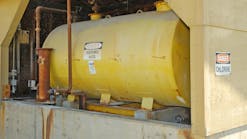Carlisle, Pa., is known to many as the town where the Pittsburgh Steelers once trained in the summer. This is where the black and gold faithful would assemble at Dickinson College to watch Lynn Swann make acrobatic catches and Jack Lambert hunt down running backs like dinner.
Maybe some of those Steelers remember taking water breaks on searing August afternoons - the cool liquid soothing their parched throats or sluicing down their faces. When the trainer turned on the tap, he took for granted the delivery of water that’s been flowing since 1853, when the Borough of Carlisle began providing water to the town and surrounding communities. Today, the water plant serves customers throughout the Borough and portions of North Middleton and Middlesex Townships.
It’s all made possible because the Carlisle Borough Municipal Authority and its partners insist that water be captured, treated and pumped under rigorous specifications. Often overlooked but equally important is how and under what conditions that water is stored - but it’s something the utility takes seriously. So when it was looking to upgrade its potable water storage it turned to Arro Consultants and Mid Atlantic Storage, who recommended the Aquastore® system from CST.
The Borough had operated since the Great Depression with two in-ground reservoirs with floating covers and recognized it was time to transition to a more efficient, cost-effective and sustainable system.
The contract was awarded in the summer of 2012 and construction took place over a 9- to 10-month period. Plans called for draining one cell at a time during construction to ensure uninterrupted service. The key was assembling the new storage tanks and putting them in service while the old units were decommissioned.
“Because the Aquastore tank is factory-coated, there’s no need to paint it in the field,” said Brian Hyde, eastern regional sales manager at Mid Atlantic Storage. “Construction took about a third of the time of a welded tank and that was a key factor in the successful completion of the job.”
Workers poured the foundation and erected the first of two tanks in late 2012 and early 2013, then put that tank in service and completed the second tank while taking the old storage cells offline one at a time. As a result, there were no glitches or interruption of service.
Mid Atlantic Storage is in its 31st year and has constructed roughly 3,800 tanks in eight states during that time, but this was the company’s first project for Carlisle Borough. “We’d done multiple tank projects with Arro Consultants and their familiarity with us made the difference,” said Hyde. “It definitely shows the importance of working with your partners time after time and gaining their trust and respect.”
One of the biggest differentiators of CST’s glass-fused-to-steel tank is its multi-step fabrication process. First, a panel of high-strength, low-carbon steel is blasted and alkaline cleaned. The edges of the panel are beveled and then it’s sprayed with a stainless steel alloy. Next, the panel is sprayed with a specially formulated slurry that gives it durability, consistency and impermeability. Unlike powder coatings or paint, the slurry is inorganic so it blocks corrosion. The panel is then fired at temperatures above 1,500°F (815°C) to fuse the porcelain coating and the steel. Finally, tests are conducted to verify integrity and durability, including high voltage testing to detect discontinuities.
The Aquastore’s glass coating makes it more resistant to extreme cold and heat than welded steel tanks. Its seamless surface means there are no cracks or crevices to attract rust and the absence of corrosion or leakage greatly mitigates the chance of hazardous runoff or leaching.
The Aquastore’s minimal maintenance requirements translate to significantly lower long-term costs than that of bolted tanks. For example, repainting the interior and exterior of a welded tank costs more than three times as much as replacing the interior and exterior fillets (sealants) of the glass-fused-to-steel tank. A municipal water provider in South Dakota estimated that maintenance for a glass-fused-to-steel tank over a 60-year span would cost $266,000 compared to $906,000 for a painted welded tank.
Another important feature is the ability to easily expand an Aquastore tank. The free-span, geodesic aluminum dome roof is constructed first, and then lifted into the air with a jacking system so the individual steel panels can be assembled underneath. Crews don’t have to leave the ground and the whole process takes as little as four feet of space beyond the tank foundation.
“This way you can expand the tank vertically,” said Hyde. “We built a foundation for a larger tank so the Borough can expand from a 28-foot sidewall height with capacity 1,290,000 gallons to a 48-foot sidewall height with capacity of 2,170,000 gallons.”
And that brings great efficiencies to Carlisle Borough should it decide to expand service to other municipalities.
“We’ve seen a great deal of demand for the expanding tanks,” said Hyde, whose company is an authorized distributor for Aquastore. “An increasing number of municipalities have taken advantage of that because they like to know they can efficiently maximize their storage capacity.”
The job went without a hitch due in part to the adaptability of Aquastore, which can easily accommodate internal systems. The Borough installed a mixing system to maintain acceptable trihalomethane (THM) levels and to keep the water from freezing. Despite single-digit temperatures for days on end in the winter of 2014-15, the water in the Aquastore tanks never froze.
Hyde has taken clients to CST’s factory in DeKalb, Ill., to watch the firing of the Aquastore panels. He has also shown them the Aquastore in the field, including tanks up to 25+ years old, so they can see firsthand the beauty and durability of the glass coating.
“They’re often surprised to learn these tanks have already survived a number of summers and winters because their finish looks like new,” said Hyde.
The Borough is already seeing the many advantages of using glass-fused-to-steel tanks for potable water storage. Besides ease of assembly, they have greater lifetime value, far lower maintenance costs and little environmental impact compared with other liquid storage structures.
“We couldn’t be happier with our Aquastore tanks,” said Pete Selan, treatment plants director for the Borough of Carlisle. “From performance to maintenance to appearance, they’ve exceeded our expectations and given us a permanent solution that will meet our needs for decades to come.”
More WaterWorld Current Issue Articles
More WaterWorld Archives Issue Articles





